Progress in Remote Sensing and GIS-Based FDI Research Based on Quantitative and Qualitative Analysis
Abstract
1. Introduction
2. Research Methods and Data
2.1. Research Methods
- (1)
- The collection of publications according to specific topics;
- (2)
- The selection of relevant journal articles and dissertations;
- (3)
- The documentation of these materials in a coherent structure;
- (4)
- The study and analysis of these materials;
- (5)
- The summary of the findings.
2.2. Data Sources and Screening
2.3. Data Processing
3. Subject Categories and Publication Trends
3.1. Subject Evolution
3.2. Trends in the Number and Cited Times of Published Papers
4. The Intellectual Structure
4.1. Quantitative Analysis
4.2. Qualitative Analysis
4.2.1. Macro-Environmental Research at National, Regional, and City Scales
4.2.2. Global Industrial Development and Layout
4.2.3. Research on Global Value Chains
4.2.4. Micro-Information Geography of TNCs
4.2.5. Internationalization and Commercialization of Geo-Information Industry
4.2.6. Multiple Data and Interdisciplinary Approaches
5. Discussions and Conclusions
Funding
Data Availability Statement
Acknowledgments
Conflicts of Interest
| 1 | The website of UCS is https://www.ucsusa.org/resources/satellite-database (accessed on 13 July 2024). One date of launch is missing from the data set, but this has a minimal impact on the overall trend. |
| 2 | The CiteSpace software (Version 6.3.1 at https://sourceforge.net/projects/citespace/files/, accessed on 13 July 2024) is selected as the primary quantitative analysis tool in this paper. |
References
- Friedmann, J. The world city hypothesis. Dev. Chang. 1986, 17, 69–83. [Google Scholar] [CrossRef]
- Sassen, S. The Global City: New York, London, Tokyo; Princeton University Press: Princeton, NJ, USA, 2001. [Google Scholar]
- Scott, A.J. Global City-Regions: Trends, Theory, Policy; Oxford University Press: Oxford, UK, 2001. [Google Scholar]
- Gregory, D.; Johnston, R.; Pratt, G.; Watts, M.; Whatmore, S. The Dictionary of Human Geography; Wiley-Blackwell: New York, NY, USA, 2009; pp. 395–396, 771–772. [Google Scholar]
- Dicken, P. Global Shift: Mapping the Changing Contours of the World Economy, 7th ed.; Guilford Press: New York, NY, USA, 2015. [Google Scholar]
- Coe, N.M.; Hess, M.; Yeung, H.W.; Dicken, P.; Henderson, J. ‘Globalizing’regional development: A global production networks perspective. Trans. Inst. Br. Geogr. 2004, 29, 468–484. [Google Scholar] [CrossRef]
- Baker, J.C.; Williamson, R.A. Satellite imagery activism: Sharpening the focus on tropical deforestation. Singap. J. Trop. Geogr. 2006, 27, 4–14. [Google Scholar] [CrossRef]
- Charles, K.P.; Adolfo, C. Mascarenhas. Remote sensing in development. Science 1981, 214, 139–145. [Google Scholar]
- Torraco, R.J. Writing integrative literature reviews: Guidelines and examples. Hum. Resour. Dev. Rev. 2005, 4, 356–367. [Google Scholar] [CrossRef]
- Snyder, H. Literature review as a research methodology: An overview and guidelines. J. Bus. Res. 2019, 104, 333–339. [Google Scholar] [CrossRef]
- Torraco, R.J. Writing integrative literature reviews: Using the past and present to explore the future. Hum. Resour. Dev. Rev. 2016, 15, 404–428. [Google Scholar] [CrossRef]
- Watson, R.T.; Webster, J. Analysing the past to prepare for the future: Writing a literature review a roadmap for release 2.0. J. Decis. Syst. 2020, 29, 129–147. [Google Scholar] [CrossRef]
- Onwuegbuzie, A.J.; Leech, N.L.; Collins, K.M.T. Qualitative analysis techniques for the review of the literature. Qual. Rep. 2012, 17, 1–28. [Google Scholar] [CrossRef]
- Su, D.Z. GIS-based urban modelling: Practices, problems, and prospects. Int. J. Geogr. Inf. Sci. 1998, 12, 651–671. [Google Scholar] [CrossRef]
- Rozas, L.W.; Klein, W.C. The Value and Purpose of the Traditional Qualitative Literature Review. J. Evid.-Based Soc. Work. 2010, 7, 387–399. [Google Scholar] [CrossRef]
- Chen, C. CiteSpace II: Detecting and visualizing emerging trends and transient patterns in scientific literature. J. Am. Soc. Inf. Sci. Technol. 2006, 57, 359–377. [Google Scholar] [CrossRef]
- Chen, C. Science map: A systematic review of the literature. J. Data Inf. Sci. 2017, 2, 1–40. [Google Scholar]
- Davis, J.; Mengersen, K.; Bennett, S.; Mazerolle, L. Viewing systematic reviews and meta-analysis in social research through different lenses. SpringerPlus 2014, 3, 1–9. [Google Scholar] [CrossRef] [PubMed]
- Svensson, R.B.; Haggar, G.J.A.; Aurum, A.; Hooper, V.J. The application of geographical information systems to multinational finance corporations. Int. J. Bus. Syst. Res. 2009, 3, 437–455. [Google Scholar] [CrossRef]
- Weber, P.; Chapman, D. Investing in geography: A GIS to support inward investment. Comput. Environ. Urban Syst. 2009, 33, 1–14. [Google Scholar] [CrossRef]
- Horn, S.A.; Cross, A.R. Japanese production networks in India: Spatial distribution, agglomeration and industry effects. Asia Pac. Bus. Rev. 2016, 22, 612–640. [Google Scholar] [CrossRef]
- Özdoğan, M.; Baird, I.G.; Dwyer, M.B. The role of remote sensing for understanding large-scale rubber concession expansion in Southern Laos. Land 2018, 7, 55. [Google Scholar] [CrossRef]
- Wang, X.; Zhang, Y.; Zhang, J.; Fu, C.; Zhang, X. Progress in urban metabolism research and hotspot analysis based on CiteSpace analysis. J. Clean. Prod. 2021, 281, 125224. [Google Scholar] [CrossRef]
- Chen, C.; Hu, Z.; Liu, S.; Tseng, H. Emerging trends in regenerative medicine: A scientometric analysis in CiteSpace. Expert Opin. Biol. Ther. 2012, 12, 593–608. [Google Scholar] [CrossRef]
- Seto, K.C.; Kaufmann, R.K.; Woodcock, C.E. Landsat reveals China’s farmland reserves, but they’re vanishing fast. Nature 2000, 406, 121. [Google Scholar] [CrossRef] [PubMed]
- Seto, K.C.; Woodcock, C.E.; Song, C.; Huang, X.; Lu, J.; Kaufmann, R.K. Monitoring land-use change in the Pearl River Delta using Landsat TM. Int. J. Remote Sens. 2002, 23, 1985–2004. [Google Scholar] [CrossRef]
- Tan, M.; Li, X.; Li, S.; Xin, L.; Wang, X.; Li, Q.; Li, W.; Li, Y.; Xiang, W. Modeling population density based on nighttime light images and land use data in China. Appl. Geogr. 2018, 90, 239–247. [Google Scholar] [CrossRef]
- Zhao, M.; Cheng, W.; Zhou, C.; Li, M.; Huang, K.; Wang, N. Assessing spatiotemporal characteristics of urbanization dynamics in Southeast Asia using time series of DMSP/OLS nighttime light data. Remote Sens. 2018, 10, 47. [Google Scholar] [CrossRef]
- Liu, H.Y.; Tang, Y.K.; Chen, X.L.; Poznanska, J. The determinants of Chinese outward FDI in countries along “One Belt One Road”. Emerg. Mark. Financ. Trade 2017, 53, 1374–1387. [Google Scholar] [CrossRef]
- Du, J.; Zhang, Y. Does one belt one road initiative promote Chinese overseas direct investment? China Econ. Rev. 2018, 47, 189–205. [Google Scholar] [CrossRef]
- Duan, F.; Ji, Q.; Liu, B.Y.; Fan, Y. Energy investment risk assessment for nations along China’s Belt & Road Initiative. J. Clean. Prod. 2018, 170, 535–547. [Google Scholar]
- Huang, Y. Environmental risks and opportunities for countries along the Belt and Road: Location choice of China’s investment. J. Clean. Prod. 2019, 211, 14–26. [Google Scholar] [CrossRef]
- Yuan, J.; Li, X.; Xu, C.; Zhao, C.; Liu, Y. Investment risk assessment of coal-fired power plants in countries along the Belt and Road initiative based on ANP-Entropy-TODIM method. Energy 2019, 176, 623–640. [Google Scholar] [CrossRef]
- Hussain, J.; Zhou, K.; Guo, S.; Khan, A. Investment risk and natural resource potential in “Belt & Road Initiative” countries: A multi-criteria decision-making approach. Sci. Total Environ. 2020, 723, 137981. [Google Scholar] [PubMed]
- Hashemizadeh, A.; Ju, Y.; Bamakan, S.M.H.; Le, H.P. Renewable energy investment risk assessment in belt and road initiative countries under uncertainty conditions. Energy 2021, 214, 118923. [Google Scholar] [CrossRef]
- Dell’angelo, J.; D’odorico, P.; Rulli, M.C.; Marchand, P. The tragedy of the grabbed commons: Coercion and dispossession in the global land rush. World Dev. 2017, 92, 1–12. [Google Scholar] [CrossRef]
- D’Odorico, P.; Rulli, M.C.; Dell’Angelo, J.; Davis, K.F. New frontiers of land and water commodification: Socio-environmental controversies of large-scale land acquisitions. Land Degrad. Dev. 2017, 28, 2234–2244. [Google Scholar] [CrossRef]
- Davis, K.F.; Koo, H.I.; Dell’Angelo, J.; D’Odorico, P.; Estes, L.; Kehoe, L.J.; Kharratzadeh, M.; Kuemmerle, T.; Machava, D.; Pais, A.d.J.R.; et al. Tropical forest loss enhanced by large-scale land acquisitions. Nat. Geosci. 2020, 13, 482–488. [Google Scholar] [CrossRef]
- Liu, B.; Xue, D.; Zheng, S. Evolution and Influencing Factors of Manufacturing Production Space in the Pearl River Delta—Based on the Perspective of Global City-Region. Land 2023, 12, 419. [Google Scholar] [CrossRef]
- Tong, Y.; Zhou, H.; Jiang, L. Exploring the transition effects of foreign direct investment on the eco-efficiency of Chinese cities: Based on multi-source data and panel smooth transition regression models. Ecol. Indic. 2021, 121, 107073. [Google Scholar] [CrossRef]
- Wei, G.; Bi, M.; Liu, X.; Zhang, Z.; He, B.J. Investigating the impact of multi-dimensional urbanization and FDI on carbon emissions in the belt and road initiative region: Direct and spillover effects. J. Clean. Prod. 2023, 384, 135608. [Google Scholar] [CrossRef]
- Zou, Y.; Lu, Y.; Cheng, Y. The impact of polycentric development on regional gap of energy efficiency: A Chinese provincial perspective. J. Clean. Prod. 2019, 224, 838–851. [Google Scholar] [CrossRef]
- Schneider, A.; Seto, K.C.; Webster, D.R. Urban growth in Chengdu, Western China: Application of remote sensing to assess planning and policy outcomes. Environ. Plan. B Plan. Des. 2005, 32, 323–345. [Google Scholar] [CrossRef]
- Su, Y.; Lu, C.; Su, Y.; Wang, Z.; Huang, Y.; Yang, N. Spatio-temporal evolution of urban expansion based on a novel adjusted index and GEE: A case study of central plains urban agglomeration, China. Chin. Geogr. Sci. 2023, 33, 736–750. [Google Scholar] [CrossRef]
- Cao, R.; Zhu, J.; Tu, W.; Li, Q.; Cao, J.; Liu, B.; Zhang, Q.; Qiu, G. Integrating aerial and street view images for urban land use classification. Remote Sens. 2018, 10, 1553. [Google Scholar] [CrossRef]
- Tu, W.; Hu, Z.; Li, L.; Cao, J.; Jiang, J.; Li, Q.; Li, Q. Portraying urban functional zones by coupling remote sensing imagery and human sensing data. Remote Sens. 2018, 10, 141. [Google Scholar] [CrossRef]
- Yu, D.; Wei, Y.D. Spatial data analysis of regional development in Greater Beijing, China, in a GIS environment. Pap. Reg. Sci. 2008, 87, 97–119. [Google Scholar] [CrossRef]
- Cao, H.; Liu, J.; Chen, J.; Gao, J.; Wang, G.; Zhang, W. Spatiotemporal patterns of urban land use change in typical cities in the Greater Mekong Subregion (GMS). Remote Sens. 2019, 11, 801. [Google Scholar] [CrossRef]
- Krylov, V.A.; Kenny, E.; Dahyot, R. Automatic discovery and geotagging of objects from street view imagery. Remote Sens. 2018, 10, 661. [Google Scholar] [CrossRef]
- Huang, X.; Yang, J.; Li, J.; Wen, D. Urban functional zone mapping by integrating high spatial resolution nighttime light and daytime multi-view imagery. ISPRS J. Photogramm. Remote Sens. 2021, 175, 403–415. [Google Scholar] [CrossRef]
- Müller, M.F.; Penny, G.; Niles, M.T.; Ricciardi, V.; Chiarelli, D.D.; Davis, K.F.; Dell’angelo, J.; D’odorico, P.; Rosa, L.; Rulli, M.C.; et al. Impact of transnational land acquisitions on local food security and dietary diversity. Proc. Natl. Acad. Sci. USA 2021, 118, e2020535118. [Google Scholar] [CrossRef]
- Liu, B.; Xue, D.; Tan, Y. Deciphering the manufacturing production space in global city-regions of developing countries—A case of Pearl River Delta, China. Sustainability 2019, 11, 6850. [Google Scholar] [CrossRef]
- Zhang, P.; Yang, X.; Chen, H.; Zhao, S. Matching relationship between urban service industry land expansion and economy growth in China. Land 2023, 12, 1139. [Google Scholar] [CrossRef]
- Cho, K.; Goldstein, B.; Gounaridis, D.; Newell, J.P. Hidden risks of deforestation in global supply chains: A study of natural rubber flows from Sri Lanka to the United States. J. Clean. Prod. 2022, 349, 131275. [Google Scholar] [CrossRef]
- Shi, F.; Xu, H.; Hsu, W.L.; Lee, Y.C.; Zhu, J. Spatial pattern and influencing factors of outward foreign direct investment enterprises in the Yangtze River Economic Belt of China. Information 2021, 12, 381. [Google Scholar] [CrossRef]
- Yin, Y.; Liu, Y. Investment suitability assessment based on B&R symbiotic system theory: Location choice of China’s OFDI. Systems 2022, 10, 195. [Google Scholar] [CrossRef]
- Liu, C.; Yan, S. Transnational technology transfer network in China: Spatial dynamics and its determinants. J. Geogr. Sci. 2022, 32, 2383–2414. [Google Scholar] [CrossRef]
- Xu, Y.; Zuo, X.L. Technology roadmapping of geo-spatial information and application services industry in China. Forum Sci. Technol. China 2016, 4, 30–36. [Google Scholar]
- Robinson, D.K.R.; Mazzucato, M. The evolution of mission-oriented policies: Exploring changing market creating policies in the US and European space sector. Res. Policy 2019, 48, 936–948. [Google Scholar] [CrossRef]
- Auque, F. The space industry in the context of the European aeronautics and defence sector. Air Space Eur. 2000, 2, 22–25. [Google Scholar] [CrossRef]
- George, K.W. The economic impacts of the commercial space industry. Space Policy 2019, 47, 181–186. [Google Scholar] [CrossRef]
- von Maurich, O.; Golkar, A. Data authentication, integrity and confidentiality mechanisms for federated satellite systems. Acta Astronaut. 2018, 149, 61–76. [Google Scholar] [CrossRef]
- Zelnio, R.J. Whose jurisdiction over the US commercial satellite industry? Factors affecting international security and competition. Space Policy 2007, 23, 221–233. [Google Scholar] [CrossRef]
- Naqvi, S.A.A.; Naqvi, R.Z. Geographical information systems (GIS) in industry 4.0: Revolution for sustainable development. In Handbook of Smart Materials, Technologies, and Devices: Applications of Industry 4.0; Springer International Publishing: Cham, Switzerland, 2021; pp. 1–27. [Google Scholar]
- Kleemann, J.; Baysal, G.; Bulley, H.N.N.; Fürst, C. Assessing driving forces of land use and land cover change by a mixed-method approach in north-eastern Ghana, West Africa. J. Environ. Manag. 2017, 196, 411–442. [Google Scholar] [CrossRef]
- Chen, W.; Huang, H.; Dong, J.; Zhang, Y.; Tian, Y.; Yang, Z. Social functional mapping of urban green space using remote sensing and social sensing data. ISPRS J. Photogramm. Remote Sens. 2018, 146, 436–452. [Google Scholar] [CrossRef]
- Seto, K.C.; Kaufmann, R.K. Modeling the drivers of urban land use change in the Pearl River Delta, China: Integrating remote sensing with socioeconomic data. Land Econ. 2003, 79, 106–121. [Google Scholar] [CrossRef]

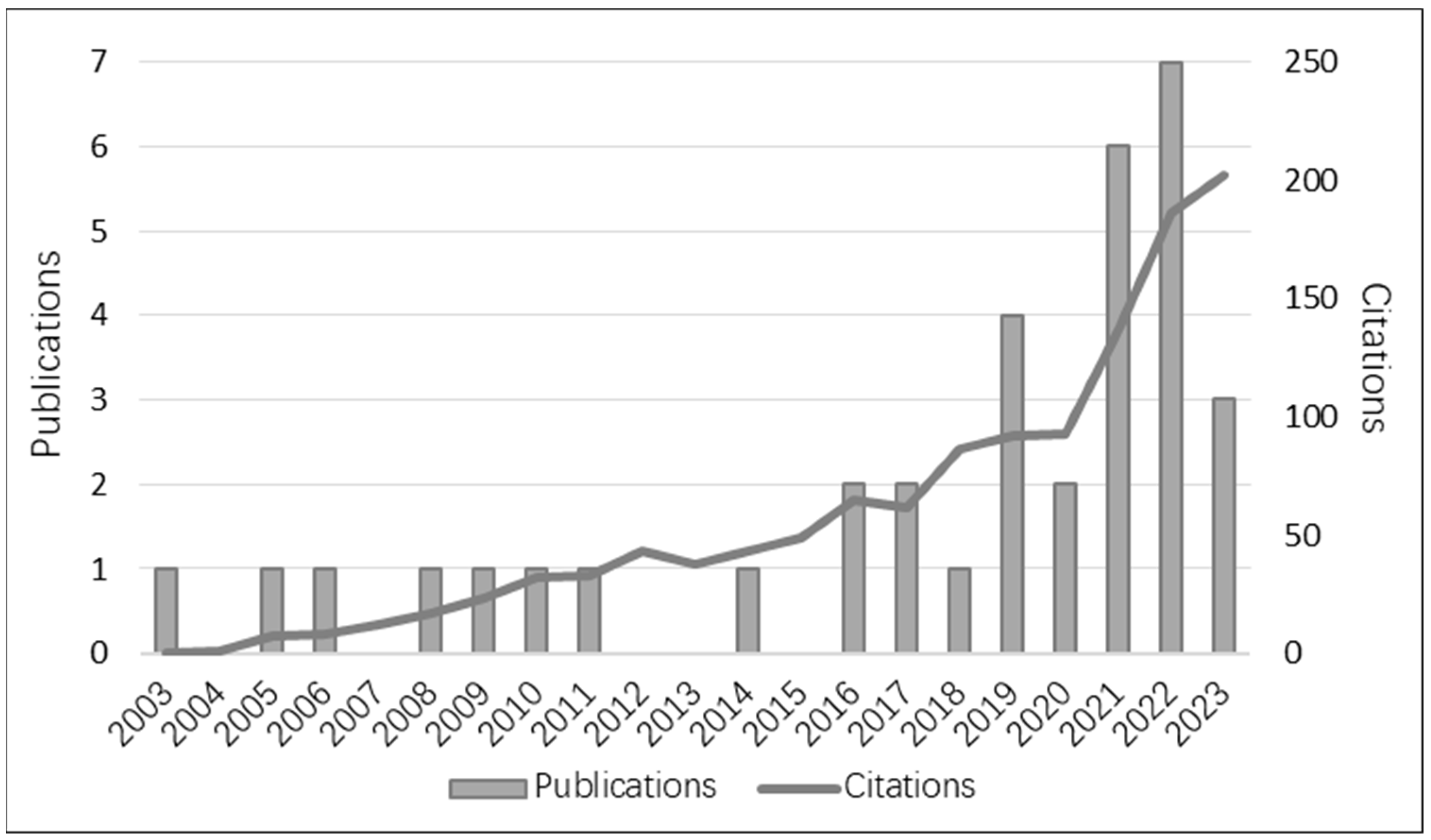
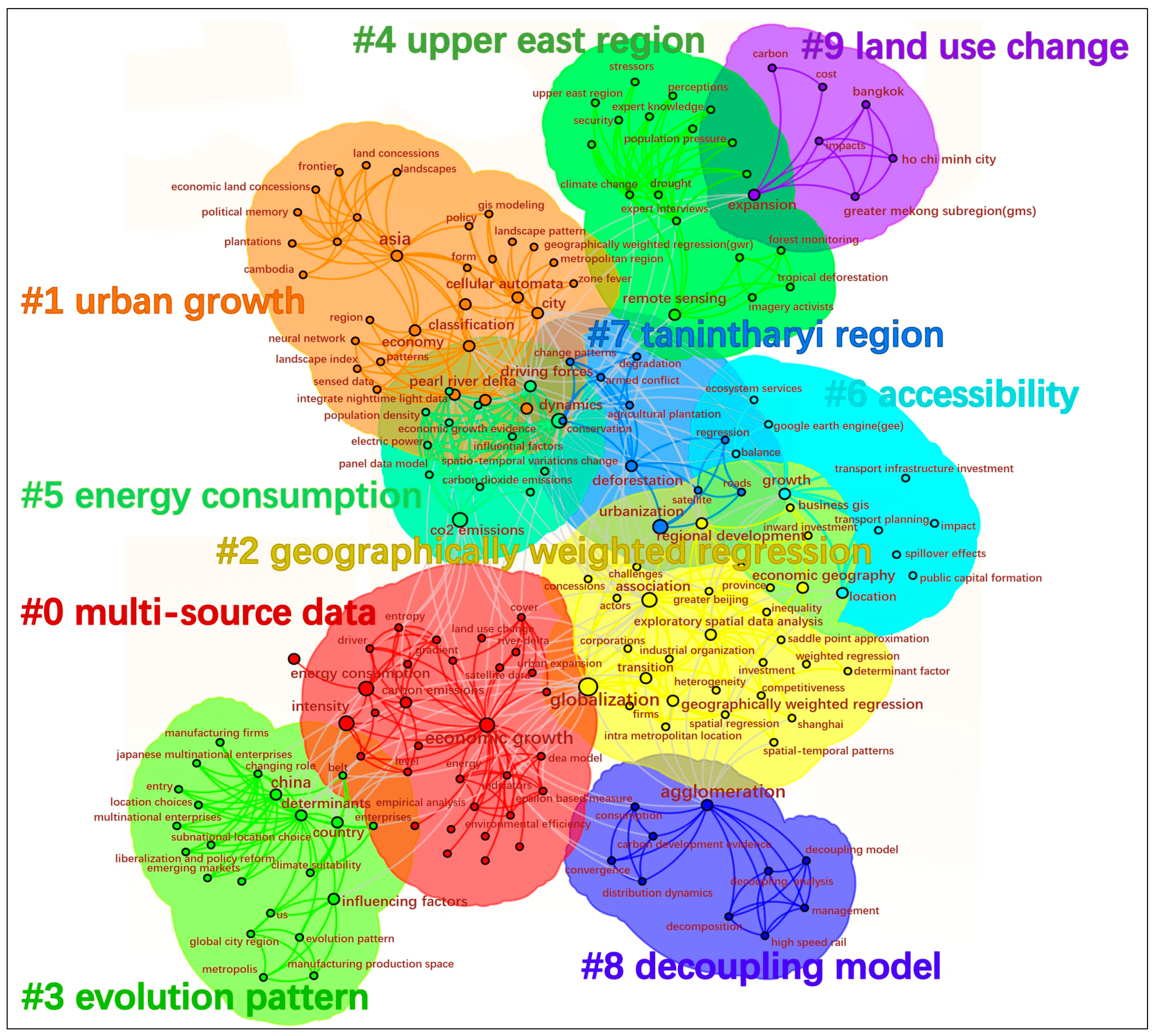
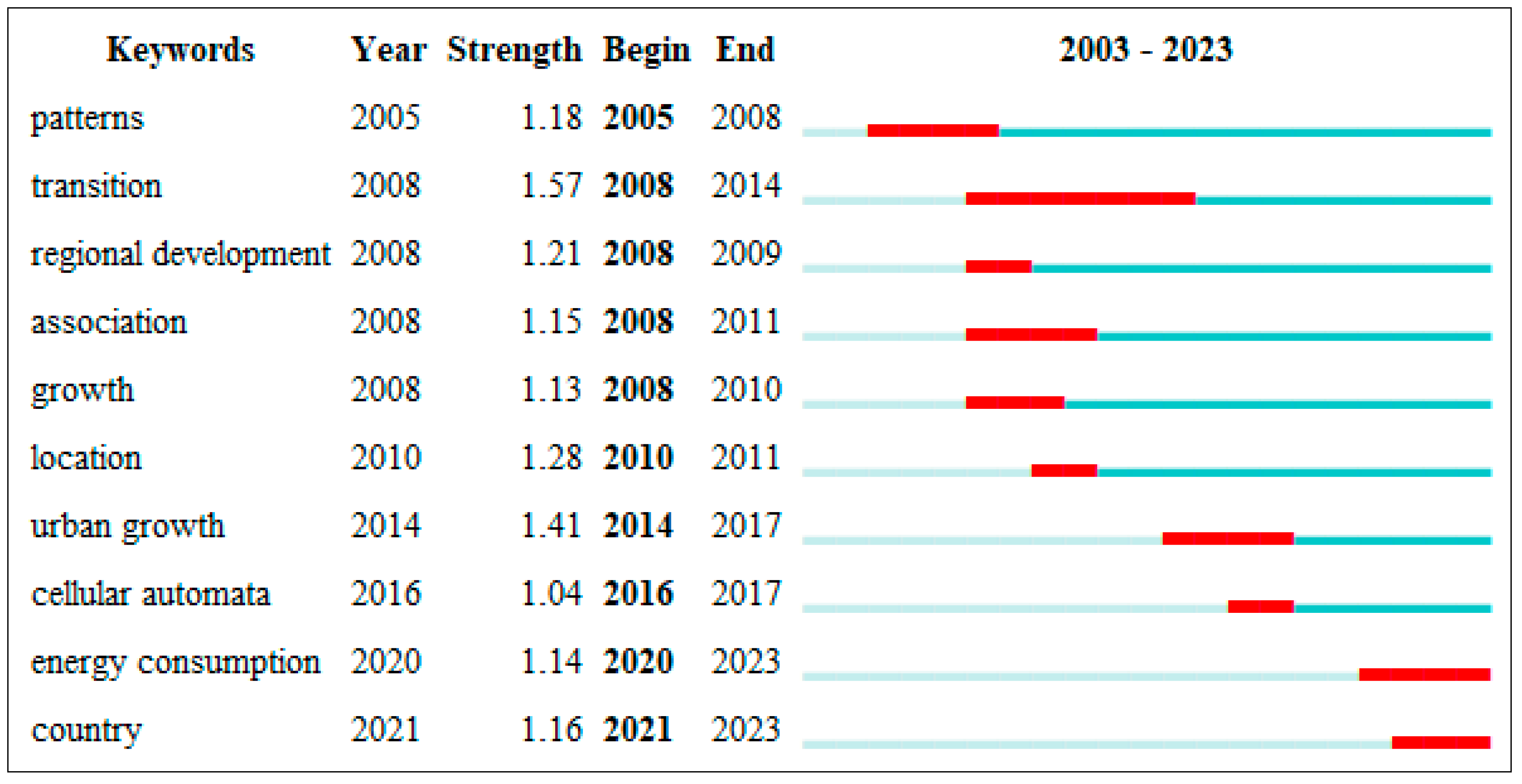
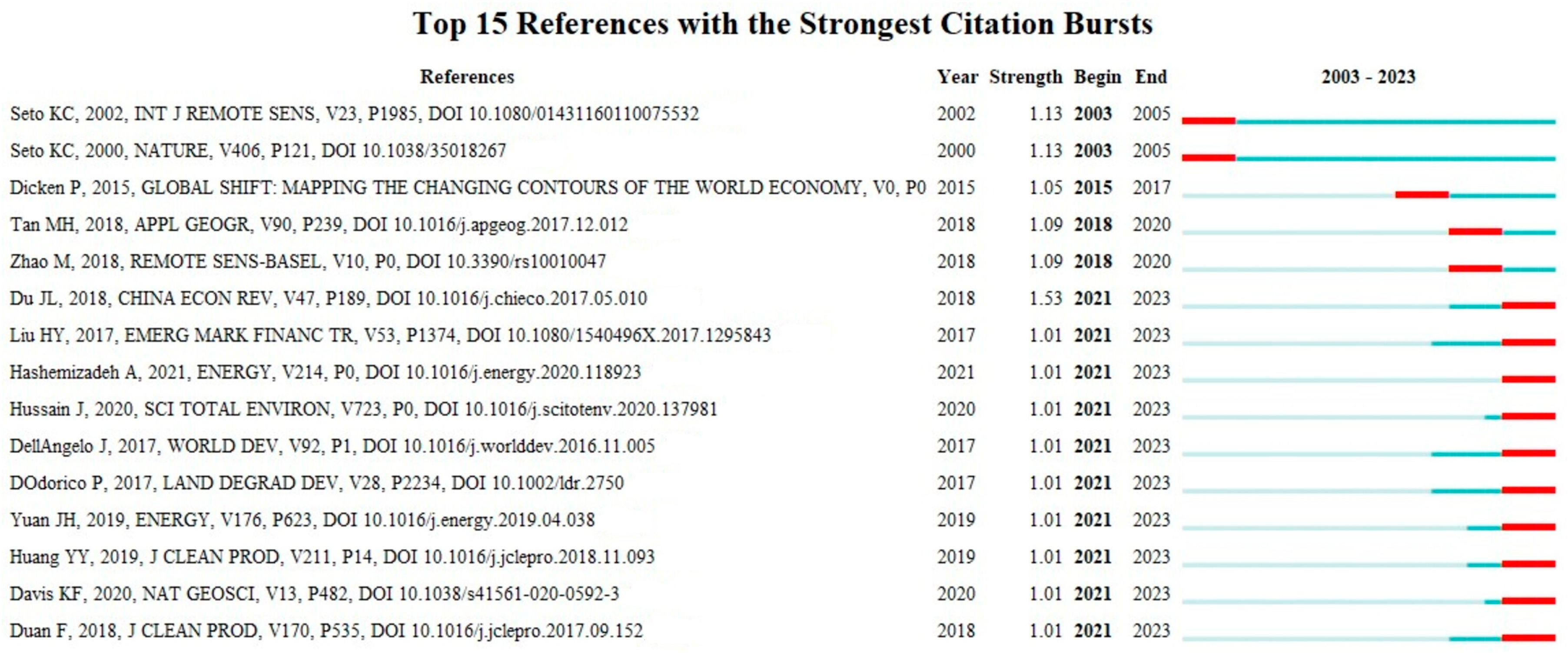
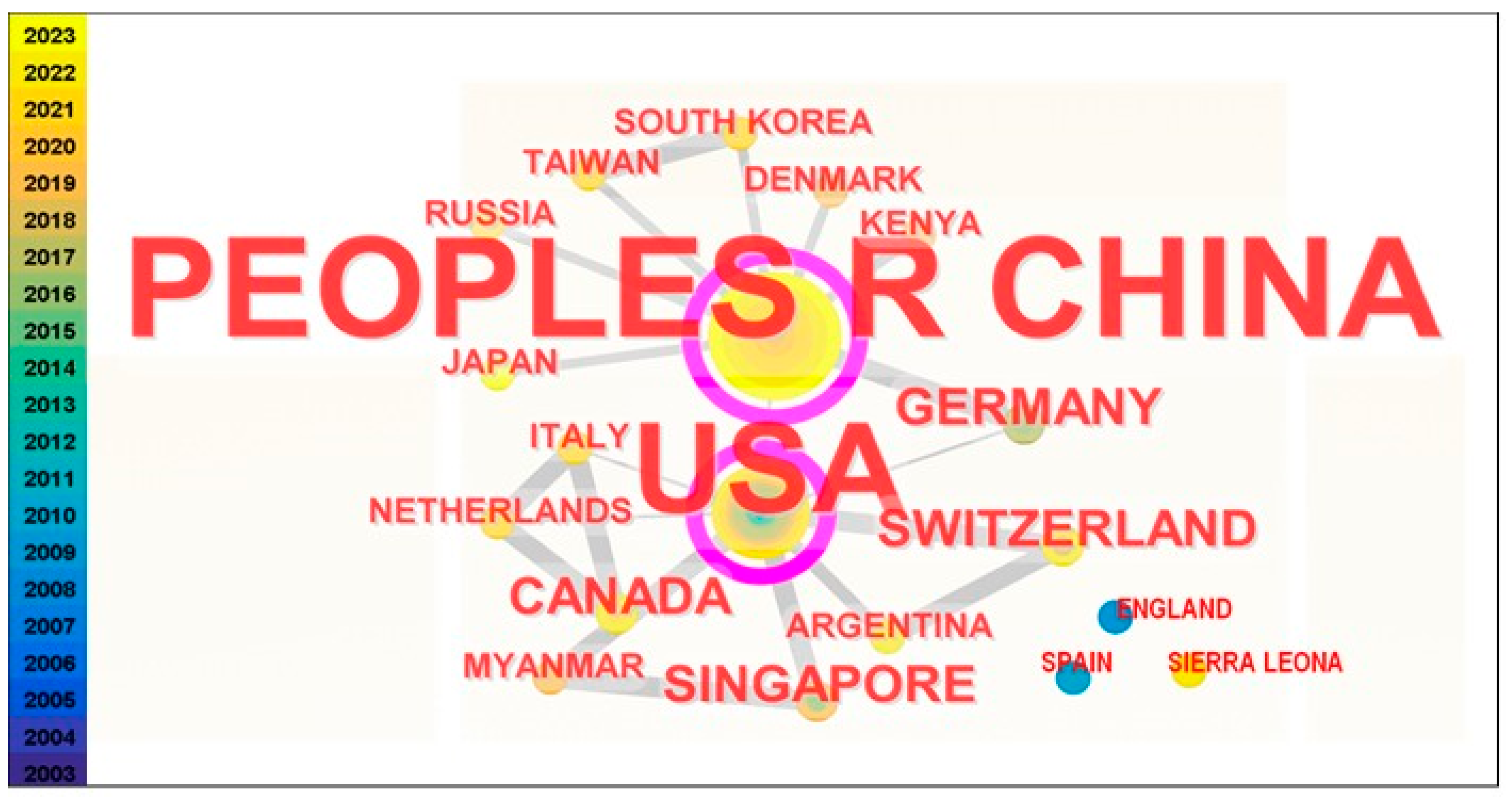
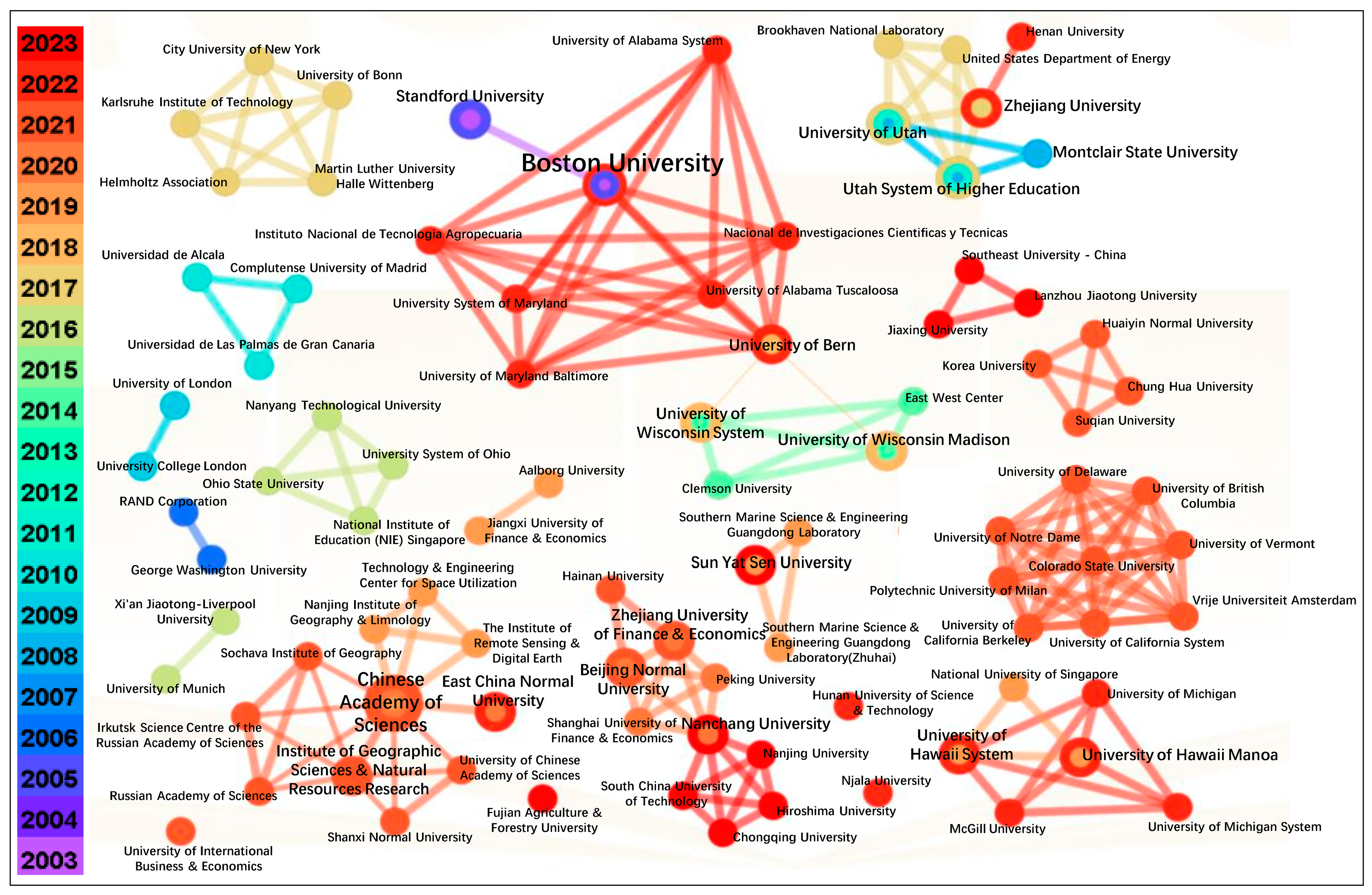
| Step | Description | Details |
|---|---|---|
| 1 | Topic identification | Identify a knowledge domain using the broadest possible terms |
| 2 | Data collection | Collect data of commonly used sources of scientific literature |
| 3 | Terms extract | Extract research front terms |
| 4 | Time slicing | Build time series models over time |
| 5 | Outcome layout | Analyze domains and generate visualizations |
Disclaimer/Publisher’s Note: The statements, opinions and data contained in all publications are solely those of the individual author(s) and contributor(s) and not of MDPI and/or the editor(s). MDPI and/or the editor(s) disclaim responsibility for any injury to people or property resulting from any ideas, methods, instructions or products referred to in the content. |
© 2024 by the author. Licensee MDPI, Basel, Switzerland. This article is an open access article distributed under the terms and conditions of the Creative Commons Attribution (CC BY) license (https://creativecommons.org/licenses/by/4.0/).
Share and Cite
Li, Z. Progress in Remote Sensing and GIS-Based FDI Research Based on Quantitative and Qualitative Analysis. Land 2024, 13, 1313. https://doi.org/10.3390/land13081313
Li Z. Progress in Remote Sensing and GIS-Based FDI Research Based on Quantitative and Qualitative Analysis. Land. 2024; 13(8):1313. https://doi.org/10.3390/land13081313
Chicago/Turabian StyleLi, Zifeng. 2024. "Progress in Remote Sensing and GIS-Based FDI Research Based on Quantitative and Qualitative Analysis" Land 13, no. 8: 1313. https://doi.org/10.3390/land13081313
APA StyleLi, Z. (2024). Progress in Remote Sensing and GIS-Based FDI Research Based on Quantitative and Qualitative Analysis. Land, 13(8), 1313. https://doi.org/10.3390/land13081313






